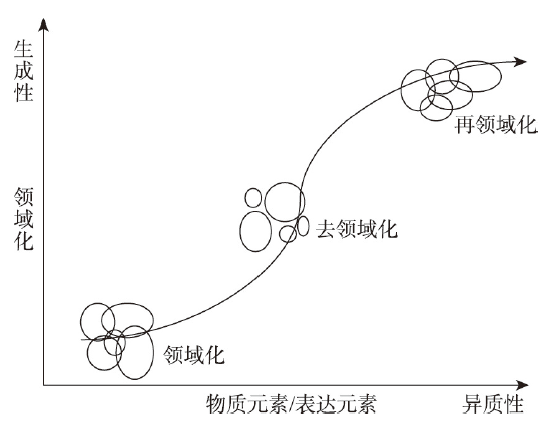

The application and prospect of assemblage theory in human geography research
Received date: 2021-10-06
Revised date: 2022-08-26
Online published: 2022-12-09
Supported by
National Natural Science Foundation of China(42071191)
National Natural Science Foundation of China(42071189)
National Natural Science Foundation of China(42101232)
Guangdong Provincial Key Laboratory of Philosophy and Social Sciences in Colleges and Universities(2022 WSYS004)
Against the background of the French "May Wave" and the postmodernist, the theory of assemblage as a research perspective starts to gain momentum. This paper proposes a philosophical view of "becoming" based on rhizome thinking, which critically exposes ignorance of the spatial topology in the current research based on network structure and opens up a new field of the knowledge for human geography. On the one hand, the assemblage theory forms a "heterogeneous generated space" on the basis of spatial theories such as "spatial production theory", "heterotopia" and "third space", emphasizing the interactions of the heterogeneous elements while also paying attention to the logic of the continuous generation and spatio-temporal change; on the other hand, the assemblage theory reconstructs the concept of relations, emphasizes the "object agency" and "relations of exteriority", which generates the "post-relational ontology" and acknowledges that all things are assembled through relations. With the application of the assemblage theory in the field of human geography, the existing empirical research mainly focuses on political assemblage and mobility, urban assemblage and critical urbanism, daily life assemblage and non-human agency, and compared with other related theories such as Complexity Theory and Actor Network Theory. In order to expound the connotation of the assemblage theory and enhance the applicability of the theory, the article analyzes the assemblage logic through border assemblage. In addition, based on the new research framework and theoretical paradigm constructed by the assemblage theory for human geography, as well as the coupling of the theoretical characteristics and the transitional period of Chinese society, it is expected that Chinese geographers can critically engage into the assemblage theory to explain the Chinese situation, as well as promoting the diversities of the Chinese geography theory and philosophical methodology.

Key words: assemblage theory; post-relational ontology; mobility; heterogeneity; becoming; rhizome
CAI Xiaomei , CAO Jing , LIU Jun . The application and prospect of assemblage theory in human geography research[J]. Acta Geographica Sinica, 2022 , 77(10) : 2633 -2649 . DOI: 10.11821/dlxb202210014
| [1] |
|
| [2] |
|
| [3] |
|
| [4] |
|
| [5] |
|
| [6] |
|
| [7] |
|
| [8] |
|
| [9] |
|
| [10] |
|
| [11] |
|
| [12] |
|
| [13] |
|
| [14] |
|
| [15] |
|
| [16] |
|
| [17] |
|
| [18] |
[麦永雄. 光滑空间与块茎思维: 德勒兹的数字媒介诗学. 文艺研究, 2007(12): 75-84, 183.]
|
| [19] |
蔡晓梅, 刘美新. 后结构主义背景下关系地理学的研究进展. 地理学报, 2019, 74(8): 1680-1694.]
|
| [20] |
|
| [21] |
|
| [22] |
|
| [23] |
赵弋徵, 陈品宇, 孔翔. 新物质主义视角下的消费地理研究进展与反思. 地理科学进展, 2021, 40(8): 1419-1429.]
|
| [24] |
|
| [25] |
|
| [26] |
|
| [27] |
|
| [28] |
|
| [29] |
|
| [30] |
|
| [31] |
|
| [32] |
|
| [33] |
|
| [34] |
吕拉昌. “城市空间转向”与新城市地理研究. 世界地理研究, 2008, 17(1): 32-38.]
|
| [35] |
|
| [36] |
|
| [37] |
[赵静蓉. 作为时间概念的城市: 记忆与乌托邦的两个维度. 探索与争鸣, 2018(10): 122-127, 144.]
|
| [38] |
|
| [39] |
|
| [40] |
|
| [41] |
|
| [42] |
|
| [43] |
|
| [44] |
|
| [45] |
|
| [46] |
|
| [47] |
|
| [48] |
|
| [49] |
[蔡晓梅, 朱竑. 新时代面向美好生活的日常生活地理与城乡休闲: “生活地理与城乡休闲”专栏解读. 地理研究, 2019, 38(7): 1557-1565.]
|
| [50] |
|
| [51] |
|
| [52] |
[李天祥, 刘星宇, 王容博, 等. 2000—2019年全球猪肉贸易格局演变及其对中国的启示: 基于复杂贸易网络分析视角. 自然资源学报, 2021, 36(6): 1557-1572.]
|
| [53] |
陈一壮. 论埃德加·莫兰复杂性思想的三个理论柱石. 自然辩证法研究, 2007, 23(12): 6-10.]
|
| [54] |
|
| [55] |
|
| [56] |
|
| [57] |
|
| [58] |
|
| [59] |
|
| [60] |
|
| [61] |
|
| [62] |
|
| [63] |
|
| [64] |
|
| [65] |
[林煦丹, 朱竑, 尹铎. 物质地理学的研究进展和启示: 追踪物质(following the things)视角. 地理科学进展, 2021, 40(7): 1235-1245.]
|
| [66] |
|
| [67] |
尹铎, 朱竑. 云南典型山地乡村农业扶贫的机制与效应研究: 以特色经济作物种植为例. 地理学报, 2022, 77(4): 888-899.]
|
| [68] |
|
| [69] |
|
| [70] |
|
/
| 〈 |
|
〉 |